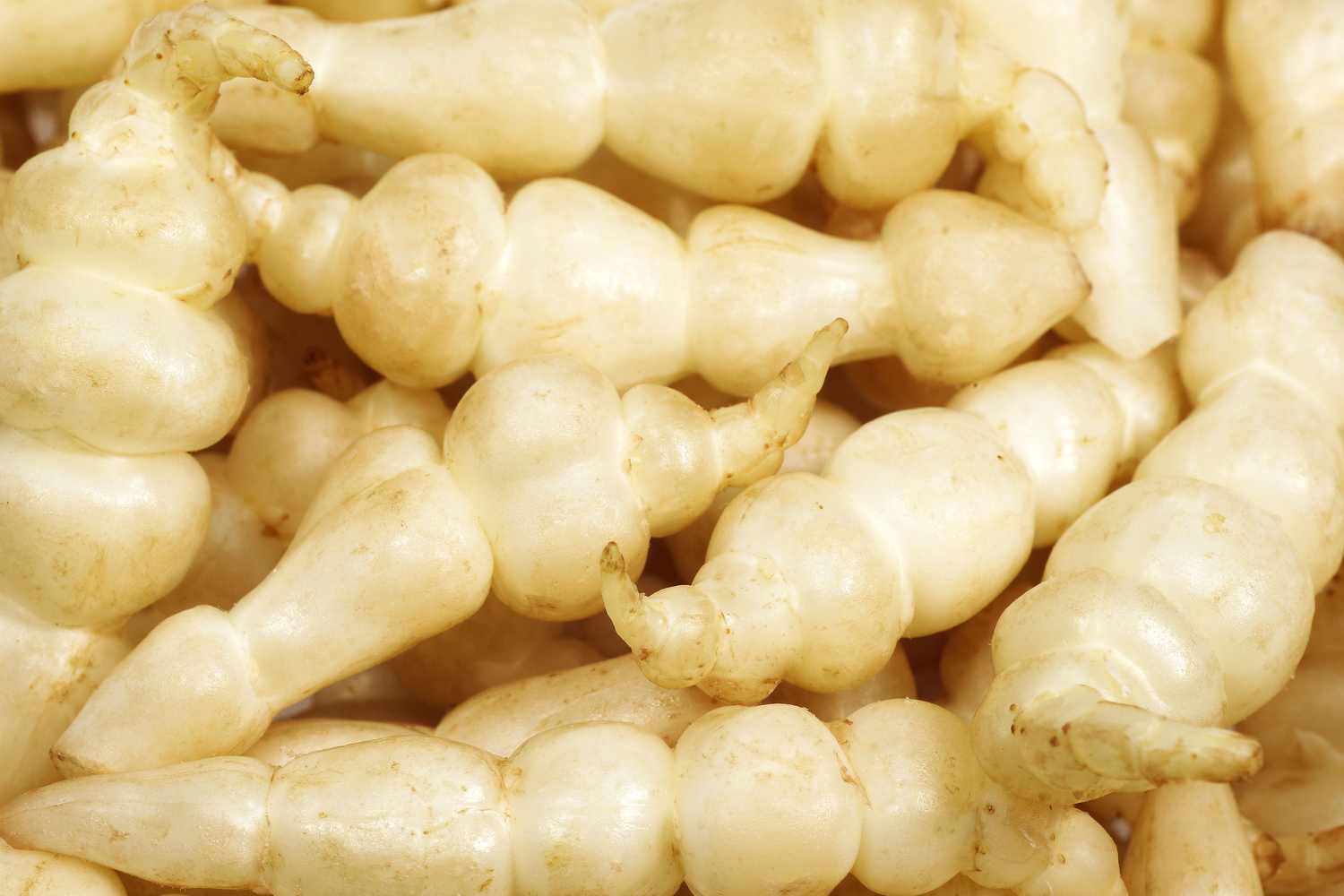Discovering Stachys affinis, also called crosne, the pearl-shaped rhizome that comes from China. Complete guide to growing the so-called Chinese artichoke, advice on preservation, and some recipes for cooking a forgotten vegetable rediscovered by gourmet cuisine.

Table of contents
There’s a vegetable you’ve probably never seen at the supermarket. It has a bizarre shape, at times unsettling, resembling small white caterpillars, but also pearls strung on an invisible thread. Behind this unusual appearance lies an ancient and refined vegetable, forgotten for decades and now rediscovered by great chefs. It’s called Stachys affinis, a plant belonging to the Lamiaceae family (the same as, among others, basil, rosemary, sage, mint, and thyme) and known by more evocative names such as crosne, tuberina, or Chinese artichoke.
A vegetable from far away
Native to central and northern China, this plant was already cultivated in the 13th century. Unlike its aromatic relatives, tuberina produces underground edible rhizomes about 3.1 inches (8 cm) long and 0.8 inches (2 cm) thick, with that characteristic spiral shape that makes them unmistakable.

The plant grows as a bush reaching between 12 and 47 inches (30 to 120 cm) in height, with rough leaves similar to nettle and flowers ranging from red to purple. But it’s underground where the magic happens: the tubers develop with constrictions at irregular intervals, creating that peculiar segmented shape. The skin is thin, light beige or ivory colored, while the internal flesh is white and tender.
The journey of crosne to Europe
In 1882 cultivation arrived in Europe for the first time, precisely on a farm in Crosne, a French town from which it took the name by which it’s still known in France today. France was the first European country to import this ancient vegetable from the East and remains the place where its culture is most deeply rooted.

At the beginning of the 20th century, crosne enjoyed considerable popularity in Europe. Alexandre Dumas cited it in 1887 as an ingredient in his “Japanese salad” in the theatrical play “Francillon.” During the world wars it became an important food, although this very association with periods of deprivation contributed, in the postwar period, to its decline. In the 1970s cultivation was abandoned due to viral problems and the plant’s strong tendency to spread invasively. Only from 1990 onwards has there been a new revival, with high-end restaurants bringing this precious ingredient back to light.
How to grow tuberina
Growing Stachys affinis is relatively simple. It’s a rustic plant that adapts to any vegetable garden, though preferring well-drained soils and sunny positions. The plant appreciates some shade during the hottest summer, while needing good sun exposure the rest of the year.
Planting is done in spring, between March and May, planting the tubers at a depth of 2-3 inches (5-8 cm) in holes spaced about 12 inches (30 cm) apart. During summer regular irrigation is needed, taking care not to create water stagnation that the plant particularly fears. Weeding is necessary, being careful not to damage the roots.
Harvest occurs from November to March, when the aerial part of the plant has dried. It’s essential that the soil not be frozen during harvest. Tuberina has an annoying characteristic: it tends to invade the garden if not controlled. However, it’s enough to pull out the regrowth 3 or 4 times the following year to completely get rid of it.
Preservation: a challenge against time
Here lies the main problem with crosne. The very thin skin means the tubers keep for only a few days, at most a week in the refrigerator. They wither and deteriorate extremely rapidly in air, so much so that they should be harvested and consumed the same day. This characteristic, combined with the difficulty of mechanizing harvest and cleaning, explains why crosne is so rare and expensive on the market.
The particular flavor of tuberina
Crosne has a crunchy texture and a sweet, delicate flavor. Depending on preparation, it recalls artichoke (hence the alternative name), hazelnut, Jerusalem artichoke, or scorzonera. It’s rich in stachyose, a tetrasaccharide consisting of galactose, glucose, and fructose, which makes it highly digestible and nutritious.
How to cook crosne
To prepare the tubers, clean them under running water, gently rubbing the thin epidermis with a brush to remove soil residues. There’s no need to peel them and they can be consumed raw, cut into pieces in salads, to appreciate their crunchiness and delicate flavor.
The simplest cooking method involves blanching them in salted water for about 10 minutes, then draining and sautéing in a pan with garlic, oil, and parsley, a method that enhances their particular taste and makes them a perfect side dish for roasted meats, especially poultry.
In Asian countries, where crosne has been part of culinary tradition for centuries, it’s mainly prepared in brine or lacto-fermented. In Japan, the tuber colored red with perilla leaves is part of osechi, the traditional New Year’s meal, and takes the name chorogi.
In contemporary Western cuisine, great chefs use crosne for refined salads and gourmet side dishes. It also lends itself to baking, seasoned with spices and aromatic herbs. The plant’s leaves can be dried and transformed into an infusion with a particular flavor.
The rarity of crosne, its extraordinary shape, and unique flavor make it a precious ingredient for those who love experimenting in the kitchen. It’s worth looking for it at farmers’ markets between November and March, or better yet trying to grow it in your own garden, because this forgotten rhizome deserves to return to our tables.
